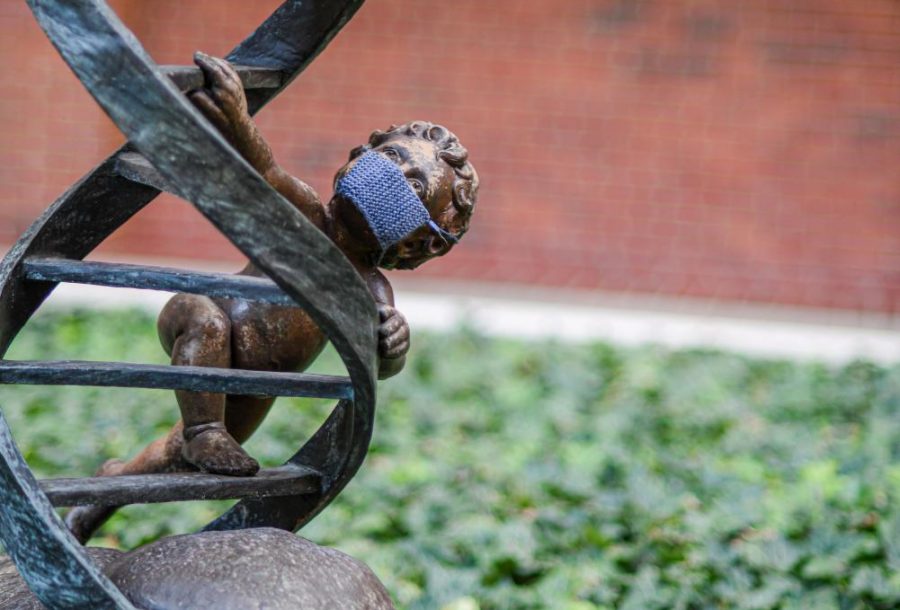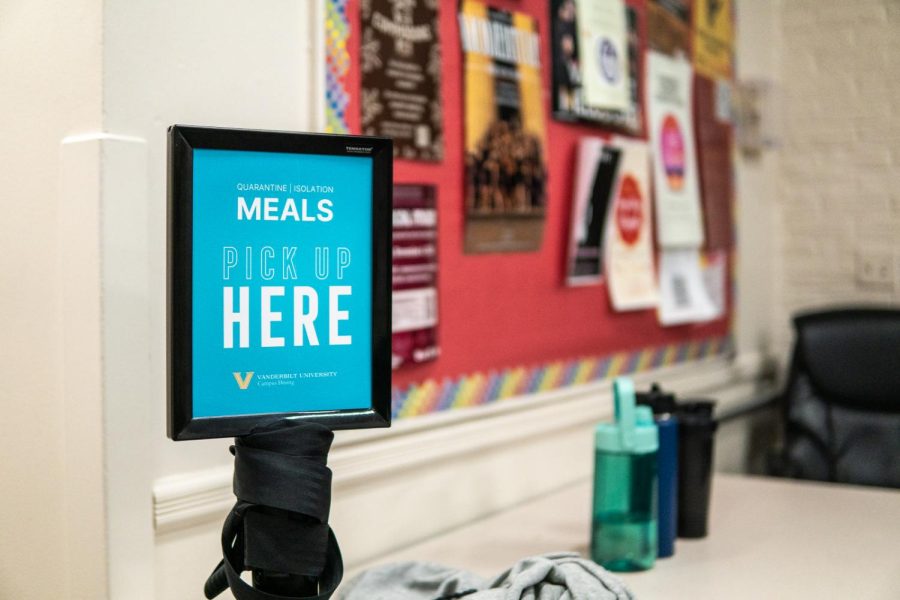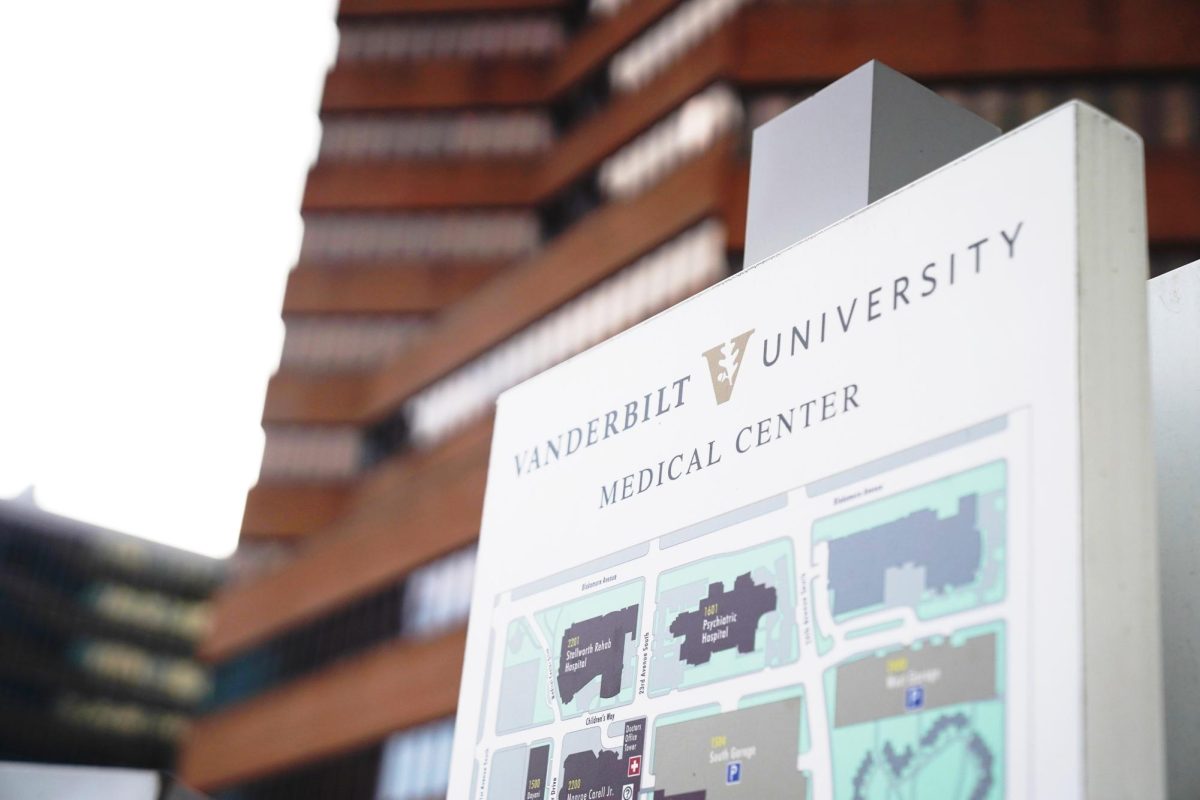Stepping onto campus this fall felt like waking up from a bad dream. Mask policies were more relaxed, dining halls were once again resounding with their characteristic chatter, we awkwardly bumped elbows sitting next to one another in classrooms and some professors even had the space to lecture maskless. It was a taste of pre-pandemic normalcy. This return to a more regular college experience was blissful and, apparently, short-lived.
With little to no warning, that nightmarish, pandemic-state of restrictions has reemerged on Vanderbilt’s campus. Suddenly, chairs are being taped off. Tables seem to disappear overnight. Dining tents are popping up again and indoor dining capacity has been cut to 50 percent. The compostable green packets of utensils and cardboard take-out boxes have reappeared in dining halls in lieu of silverware and plastic plates. Some classes have begun to offer virtual or recorded lectures.
Vanderbilt, why? Please, tell us what’s going on.
At the close of the Fall 2020 semester, The Hustler’s editorial board sat down and thanked Vanderbilt. We thanked the university for doing what it could to give us a hint of normalcy in a world where everything was changing. For bringing us to campus. For trying to foster community despite six feet of distance. For trying to keep us safe. And most importantly, for making informed choices under impossibly hard circumstances and communicating those choices clearly to the entire student body.
In the middle of the pandemic, during a time of never-ending change, one thing was constant: transparency about the state of the pandemic on our campus and resulting policies. Now, amid the rise of the delta variant, we are desperately refreshing our inboxes, hearing next to nothing. Yet, we see our classmates quarantining, campus changing and our “normal” disappearing. We know something is going on; please don’t leave us in the dark.
While the “high rate of infection in the Nashville region” is being cited as the reason for many of the new restrictions imposed on us, the infection rate at Vanderbilt is still unclear.
Despite the introduction of a COVID-19 dashboard as of Sept. 8, access to key information is still missing. Currently, the dashboard reports the weekly incidence rate of COVID-19 cases on campus, or the number of positive test results in a given population (vaccinated and unvaccinated individuals in Vanderbilt’s case). In the week of Aug. 29 this year 122 people tested positive for COVID-19, with an incidence rate of 0.56 percent of the vaccinated community and an incidence rate of 2.04 percent of the unvaccinated community. In Fall 2020, on average there were 53 cases per week with a peak of 117 cases during the week of Nov. 9, 2020. In Spring 2021 there was an average of 57 cases per week, with a peak of 279 cases during the first week of the semester, the week of Jan. 10, 2021.
During the week of Aug. 29, 2021, we saw the second highest amount of positive tests in one week since the beginning of Fall 2020. We don’t, however, have access to the positivity rate or the “percent positive” of total administered COVID-19 tests.
The Fall 2020 and Spring 2021 dashboards provided us with breakdowns of positive cases and positivity rates across five different populations (off-campus undergrad, on-campus undergrad, graduate/professional, faculty and staff/postdocs) and between symptomatic and asymptomatic cases. Our Fall 2021 dashboard is lacking all of these breakdowns. Positivity rate information is extremely valuable for the Vanderbilt population to know, as it can be used as an indicator for the level of transmission within a community. It can also be used to determine whether or not enough testing is being done on a given population.
Currently, students with symptoms are told to report to student health for testing, asymptomatic close contacts are told to get tested three days post-exposure and unvaccinated students are required to be tested weekly. Unlike Vanderbilt, most universities in Tennessee are not requiring COVID-19 vaccinations and a large portion are requiring masks indoors. Nearby universities such as Lipscomb University and Belmont University have published dashboards with information about COVID-19 cases on their campuses; however, neither Belmont nor Lipscomb requires asymptomatic testing and neither dashboard provides information regarding positivity rates, much like Vanderbilt.
Our peers at similar private institutions nationwide, however, are being tested at least weekly. Brown University and Duke University are both similar to Vanderbilt in size, ranking (according to the U.S. News and World Report Best Colleges rankings) and vaccination rates (97 percent, over 90 percent and near 96 percent respectively). Both Duke and Brown are testing all students weekly and are publishing the results of those tests, along with positivity rates, on public dashboards (Duke and Brown). From testing all of their students, our peer institutions have learned that COVID-19 is still spreading across campus, despite vaccinations. By providing a thorough dashboard, everyone in their communities can remain informed and make personal decisions about their health.
Testing availability is also not being communicated clearly. Students have reported going to the Student Health Center for symptomatic testing only to learn that the center has run out of rapid tests completely, leaving them to take a slower-acting test—and to quarantine or shelter in place (depending on the student’s living situation) until the results come back.
Students are also unsure of where they will be quarantining due to a lack of clarity in protocols. While some students are told to shelter-in-place while awaiting test results, others are sent to quarantine housing, which is mainly in Blakemore House, but has recently expanded to include hotel rooms; a change also not communicated to students.
Protocol regarding missed class due to quarantine is also quite unclear. Each professor seems to be handling the pandemic in a different way—while some offer daily virtual options or mandate virtual classes when they’re scheduled to be in-person, others don’t record lectures or accommodate students in quarantine. Students deserve to know what policies are in place regarding instruction while in quarantine. Per Vanderbilt’s 10-day quarantine protocol, students could miss up to five classes’ worth of content due to quarantine. As Vanderbilt students, we take rigorous courses, causing one day of missed class to be detrimental, let alone five.
It’s not just the Vanderbilt administration that needs to increase their transparency. Professors should be transparent in what accommodations they can offer students in quarantine so that students don’t feel the need to dismiss their symptoms in fear of missing content. And, despite a fear of missing classes, students should also be transparent in acknowledging their symptoms, reporting them and getting tested so that they don’t spread disease.
More transparency is needed in data on our COVID-19 dashboard and more communication is needed with regard to what policies are in place for testing, quarantining and missing class. After repeated attempts at contacting administrative and communications personnel, even the Hustler was unable to find these answers, further demonstrating an extreme lack of transparency.
Don’t misunderstand us. We want to be here. We are happy to be in-person. We are grateful for the tireless efforts of our professors and staff to keep us safe, help us learn and socialize with our peers. We’re not asking you to change what you’re doing in response to COVID-19. We just want to know what’s going on with COVID-19 on campus and why changes are being made. We deserve that communication—especially when our health is on the line.












Derek Talbot • Sep 13, 2021 at 2:54 pm CDT
Vanderbilt parent opinion: Vandy has rapidly gone from impressing students, parents, alumni and prospective students with their COVID response, policies and transparency during Fall 20 and Spring 21 semesters to rapidly losing the faith of all of these groups with the current lack of transparency and consistency for COVID response this fall combined with the dining struggles continuing/worsening, and decision to charge for attending Family Day events in Oct. Difficult times indeed, but this year is troubling as Vanderbilt Administrations appear to be deliberately non-communicative and non-responsive unless The Hustler and students/parents complain publicly. We can get “virtual” education from more local universities but as the Editorial stated, Vandy students want to be there as a community. Too many restrictions and then suddenly the Vandy experience does not live up to the promise nor the investment and looks more and more like other lesser ranked options. Our children will be better off learning how to overcome crisis like pandemics if they can do so as part of a community focused on common goals vs. being isolated—and we will all be better from their experience and learnings applied to the outside world. We are all thankful for what Vandy has done, but we are also right to challenge them to do better.
Cameron Powell • Sep 13, 2021 at 10:51 am CDT
This is exactly why we have decided…..for now…..not to financially support Vanderbilt; despite having had a recent graduate. As a physician steeped in the science of Covid, I cannot fathom why any of these restrictions are in place. We have two other sons in large universities in Texas that are 100% wide open without restriction and both students, faculty, staff and alumni are doing very well. Covid is there, but is not causing problems and life is normal. The vulnerable are vaccinated and taking precautions and rest of the nearly 50,000 students – per campus – are living their lives with virtual normalcy – rejecting the manufactured hysteria that has gripped academia. My own Ivy League alma mater is even allowing more freedom than Vanderbilt or Duke. Literally insane and not backed by legitimate science.
Karen Champagne • Sep 13, 2021 at 5:31 pm CDT
Thank you for speaking up! We agree entirely. Vanderbilt’s refusal to recognize natural immunity in mandating a “vaccine” for a student population is inexcusable. We have withdrawn all funding and won’t consider them further. We have learned via the data of the past two years that mandates have shown no effect on viral transmission. Apparently, Vanderbilt has not.
Wendy SIgna • Sep 13, 2021 at 10:42 am CDT
I am extremely concerned about some professors refusing to make available class notes, virtual lectures, online chats, etc to students having to quarantine. I belong to a parent forum and have heard nightmare stories about this very issue. It is beyond the control of the student if they must quarantine, yet no policy surrounds this for teachers??? It’s problematic and stressful, to say the least. Vanderbilt has to have information they can release on this – transparency is key!